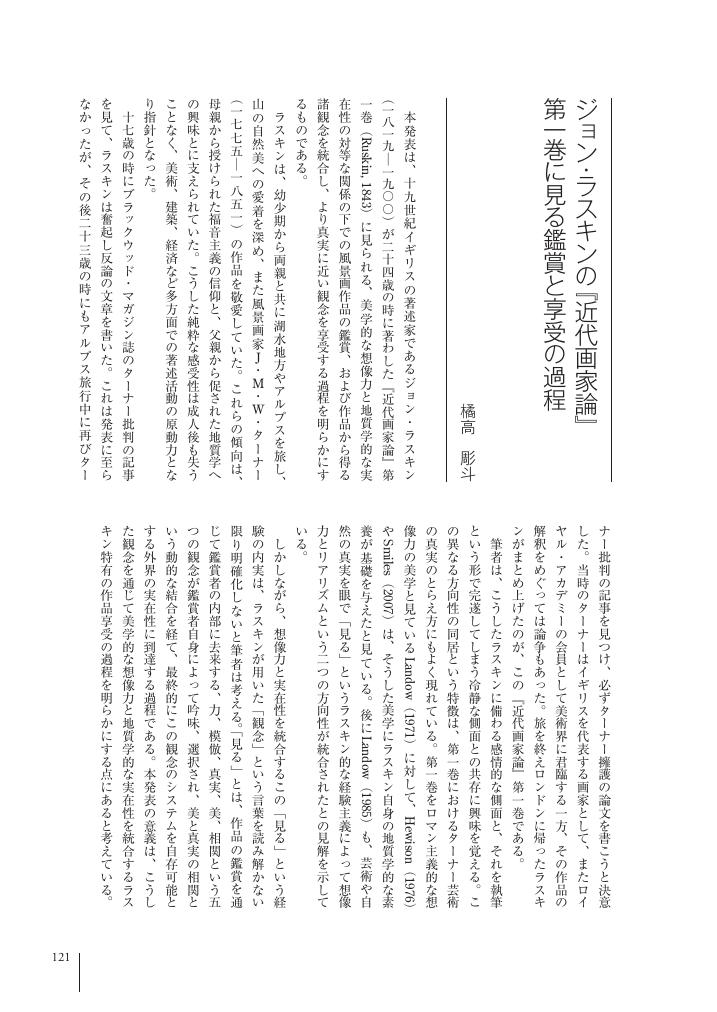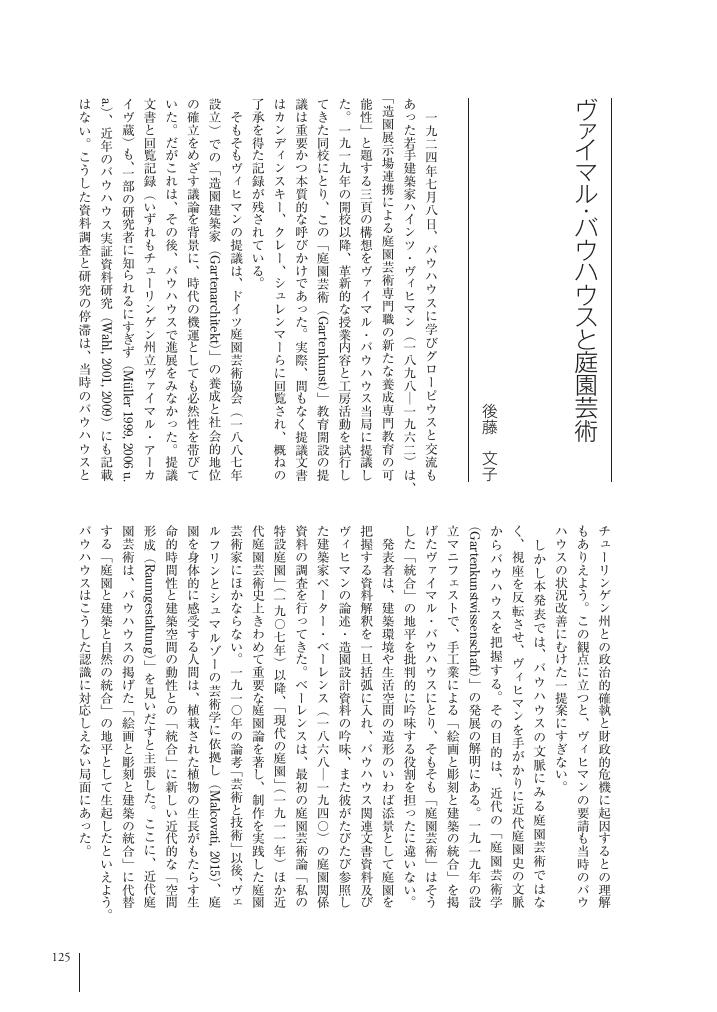- 著者
- 小松 浩之
- 出版者
- 美学会
- 雑誌
- 美学 (ISSN:05200962)
- 巻号頁・発行日
- vol.70, no.2, pp.126, 2019 (Released:2021-05-08)
1 0 0 0 OA バートルビー、蜂起の身振り ジョルジュ・ディディ = ユベルマンの欲望論を通じて
- 著者
- 佐藤 香奈穂
- 出版者
- 美学会
- 雑誌
- 美学 (ISSN:05200962)
- 巻号頁・発行日
- vol.70, no.2, pp.127, 2019 (Released:2021-05-08)
1 0 0 0 OA 「浮世絵画派」の躍進 鏑木清方の新浮世絵と 大正期の文展(日本画)・南画・版画
- 著者
- 篠原 聰
- 出版者
- 美学会
- 雑誌
- 美学 (ISSN:05200962)
- 巻号頁・発行日
- vol.70, no.2, pp.128, 2019 (Released:2021-05-08)
1 0 0 0 OA 明治中期の日本庭園における自然の表象 横井時冬『園芸考』の分析
- 著者
- スコルシ ワナ ロレダナ
- 出版者
- 美学会
- 雑誌
- 美学 (ISSN:05200962)
- 巻号頁・発行日
- vol.70, no.2, pp.129, 2019 (Released:2021-05-08)
1 0 0 0 OA ジャック・ランシエールの思想展開におけるマラルメの地位
- 著者
- 鈴木 亘
- 出版者
- 美学会
- 雑誌
- 美学 (ISSN:05200962)
- 巻号頁・発行日
- vol.70, no.2, pp.130, 2019 (Released:2021-05-08)
- 著者
- 曹 有敬
- 出版者
- 美学会
- 雑誌
- 美学 (ISSN:05200962)
- 巻号頁・発行日
- vol.70, no.2, pp.131, 2019 (Released:2021-05-08)
1 0 0 0 OA 一九三〇─四〇年代アメリカにおける ルネ・マグリットと「幻想」
- 著者
- 利根川 由奈
- 出版者
- 美学会
- 雑誌
- 美学 (ISSN:05200962)
- 巻号頁・発行日
- vol.70, no.2, pp.133, 2019 (Released:2021-05-08)
- 著者
- 富岡 進一
- 出版者
- 美学会
- 雑誌
- 美学 (ISSN:05200962)
- 巻号頁・発行日
- vol.70, no.2, pp.134, 2019 (Released:2021-05-08)
1 0 0 0 OA 銭鍾書の「虚色」論 中国の伝統的詩論の発展形
- 著者
- 丁 乙
- 出版者
- 美学会
- 雑誌
- 美学 (ISSN:05200962)
- 巻号頁・発行日
- vol.70, no.2, pp.135, 2019 (Released:2021-05-08)
1 0 0 0 OA 保田與重郎の芸術論 戦後の美術批評を中心に
- 著者
- 遠藤 太良
- 出版者
- 美学会
- 雑誌
- 美学 (ISSN:05200962)
- 巻号頁・発行日
- vol.70, no.2, pp.116, 2019 (Released:2021-05-08)
- 著者
- 大城 茉里恵
- 出版者
- 美学会
- 雑誌
- 美学 (ISSN:05200962)
- 巻号頁・発行日
- vol.70, no.2, pp.117, 2019 (Released:2021-05-08)
1 0 0 0 OA ペーター・コンヴィチュニーの《ばらの騎士》演出
- 著者
- 大矢 未来
- 出版者
- 美学会
- 雑誌
- 美学 (ISSN:05200962)
- 巻号頁・発行日
- vol.70, no.2, pp.118, 2019 (Released:2021-05-08)
1 0 0 0 OA ムンクの壁画制作における 技法選択と色彩表現 同時代ノルウェーの 言説および実践との対話
- 著者
- 亀山 裕亮
- 出版者
- 美学会
- 雑誌
- 美学 (ISSN:05200962)
- 巻号頁・発行日
- vol.70, no.2, pp.120, 2019 (Released:2021-05-08)
1 0 0 0 OA ジョン・ラスキンの『近代画家論』第一巻に見る鑑賞と享受の過程
- 著者
- 橘高 彫斗
- 出版者
- 美学会
- 雑誌
- 美学 (ISSN:05200962)
- 巻号頁・発行日
- vol.70, no.2, pp.121, 2019 (Released:2021-05-08)
- 著者
- 木村 遥
- 出版者
- 美学会
- 雑誌
- 美学 (ISSN:05200962)
- 巻号頁・発行日
- vol.70, no.2, pp.122, 2019 (Released:2021-05-08)
1 0 0 0 OA 日本映画の「日本的なもの」を めぐる諸言説 一九三〇年代の批評言説を中心に
- 著者
- 具 慧原
- 出版者
- 美学会
- 雑誌
- 美学 (ISSN:05200962)
- 巻号頁・発行日
- vol.70, no.2, pp.123, 2019 (Released:2021-05-08)
1 0 0 0 OA レンブラント作 《屠られた雄牛》をめぐって 粗い仕上げが作品に付与したもの
- 著者
- 国清 景子
- 出版者
- 美学会
- 雑誌
- 美学 (ISSN:05200962)
- 巻号頁・発行日
- vol.70, no.2, pp.124, 2019 (Released:2021-05-08)
1 0 0 0 OA ヴァイマル・バウハウスと庭園芸術
- 著者
- 後藤 文子
- 出版者
- 美学会
- 雑誌
- 美学 (ISSN:05200962)
- 巻号頁・発行日
- vol.70, no.2, pp.125, 2019 (Released:2021-05-08)
1 0 0 0 OA アドルノの自然美における二つの位相 M・ゼールによるアドルノ批判の再検討
- 著者
- 府川 純一郎
- 出版者
- 美学会
- 雑誌
- 美学 (ISSN:05200962)
- 巻号頁・発行日
- vol.70, no.2, pp.25-36, 2019 (Released:2021-05-08)
In der Ästhetischen Theorie definiert Theodor W. Adorno das Naturschöne als die Erfahrung von „der Sprache der Natur“, die weder eine begriffliche, noch eindeutig zu bestimmende Bedeutung hat. Martin Seel lehnt aber diese Sprache als einen „metaphysischen“ Begriff ab, und urteilt, dass die Naturästhetik Adornos im Grunde auf einer romantischen Betrachtungsweise aufbaut. Auf Grundlage der späteren Diskussionen über die Richtigkeit dieser Kritik (Josef Früchtl, Gerhard Schweppenhäuser, Gernot Böhme) untersucht dieser Aufsatz im Folgenden den zentralen Streitpunkt, ob diese Sprache der Natur buchstäblich aus der Natur selbst kommt oder bloß durch eine Vermittlungswirkung des Subjekts konstruiert ist. Diese Lektüre führt infolgedessen zu der Interpretation, dass in der Sprache der Natur zwei Phasen ineinander verwoben sind: die Projektionsweise, in welcher der Mensch, der im mythischen Zustand quälend gefangen ist, sein utopisches Interesse auf die Natur richtet. Und die metaphysische Phase, die in der Wahrnehmung des utopischen Interesses der Natur besteht, die im Grunde ebenfalls im grausamen mythischen Zustand gefangen ist. Diese Phase beweist zwar eine gewisse Richtigkeit der Kritik Seels, aber die Lektüre macht auch ein ästhetisches Potenzial Adornos aufmerksam.
1 0 0 0 OA オズワルド・ヂ・アンドラーヂの批評におけるブラジル性について
- 著者
- 居村 匠
- 出版者
- 美学会
- 雑誌
- 美学 (ISSN:05200962)
- 巻号頁・発行日
- vol.70, no.2, pp.61-72, 2019 (Released:2021-05-08)
This paper characterizes a Brazilian critic Oswald de Andrade’s ‘Brazilianness (brasilidade)’ by analyzing his art critique. It is accepted that ‘philosophy of anthropophagy’ proposed by Andrade’s “Anthropophagy Manifest (Manifesto Antropófago, 1928)” defines the 20th century Brazilian culture. The idea of the philosophy of anthropophagy as a cultural constructional model ignores, however, socio-political visions in Andrade’s works. I clarify the significance of art for Andrade and connect his writings of art in the modernist era and socio-political writings in his later years. Andrade praises art based on Brazilian life, nature, and history as representative art of Brazil, national art. Further, according to his review concerning Anita Malfatti’s solo exhibition in 1917, Andrade criticizes art from a western point of view. Finally, the paper clarifies representations of Brazilianness by analyzing Andrade’s critiques about two painters, Tarsila do Amaral and Lasar Segall. In conclusion, I show that Brazilianness for Andrade is an expression both based on Brazilian life, nature, and history and executed well in western criteria. Andrade’s Brazilianness is also problematic in terms of internalizing of western exoticism. At the same time, however, it is possible for the Brazilianness to subvert Eurocentrism.

















